July
 Early fall? Due to the wet months of May and June, a fungus attack on newly opening tree buds has now left its mark with an early leaf drop. Mostly Oaks, Birch, and Maple although any deciduous tree is susceptible. Brown leaves, curled edges, black spots, and a broken leaf stems are all signs to look for on those leaves. Solution? Rake and dispose of the leaves to control future outbreaks, and if we continue to have average rainfall, trees will survive this attack of the fungus. You will just have fewer leaves to rake in the fall!
Early fall? Due to the wet months of May and June, a fungus attack on newly opening tree buds has now left its mark with an early leaf drop. Mostly Oaks, Birch, and Maple although any deciduous tree is susceptible. Brown leaves, curled edges, black spots, and a broken leaf stems are all signs to look for on those leaves. Solution? Rake and dispose of the leaves to control future outbreaks, and if we continue to have average rainfall, trees will survive this attack of the fungus. You will just have fewer leaves to rake in the fall!
Beetle alert: Here they come!!! Japanese beetle adults have been observed in high numbers. I have seen adults of two species of our problematic species (Japanese beetles, and Asiatic garden beetles) active over the past two weeks. It is safe to assume that beetles are beginning to lay eggs in many areas of southern New England. Hand picking for removal is a very safe option, check the under surface of leaves for egg nests, or now would be a good time to schedule an application of a product containing imidacloprid (Merit™ and other trade names, and Allectus™, which contains Merit™ and Talstar™). In addition, chlothianidin (Arena™) is a new product that appears to be very active against white grubs. These should be applied by the end of July to be effective, and make sure you water them in good!
Want sweeter blueberries? Leave the berries on the bush for up to a week AFTER they have turned blue, they will be much sweeter!
Lawns: Keep your mower blades sharp, and raise the deck to a height of 2.5” – 3” now to encourage good root growth depth. Water your lawn only once or no more than twice a week, deeply. Frequent (daily) light sprinklings do nothing for a good lawn (and trees too!)
Speaking of watering, if you have recently planted new trees and shrubs, watering once a week deeply (slowly, 15-20 gals) is a great way to keep your plants green and growing. Water only during the early morning, or evening (till 9 am, or after 6 PM,) for best results. Use a drip hose or slow running nozzle. Do not wet the foliage (this will encourage fungal attacks, see above)

